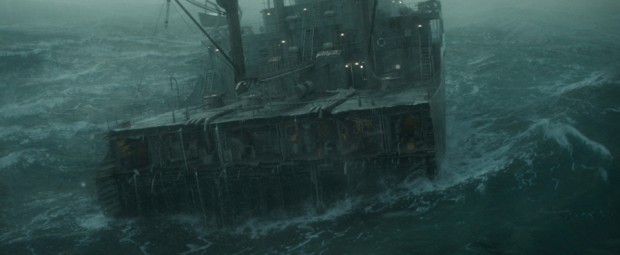Disney’s heroic action-thriller The Finest Hours, now in theaters, is the true story of the most daring small boat rescue in the history of the U.S. Coast Guard. To bring the harrowing adventure to life, director Craig Gillespie and production vfx supervisor turned to MPC to deliver roughly 900 shots across 10 months of post-production, overseen by MPC’s vfx supervisor Seth Maury and producer Felix Crawshaw.
The bulk of MPC’s work involved recreating an immersive no’easter storm, complete with ocean swells, thrashing waves, driving rain and snow to suck audiences into the perilous story, and a sequence where a 36-foot Coast Guard boat crosses a digital version of Chatham bar surrounded by 30- to 50-foot waves.
MPC built on footage shot using a large water-tank, gimbal set of the Coast Guard rescue boat, full-size mock-up of the Pendleton’s hull and a replica of the endangered boat’s engine room — as well as on-location scenes shot around Cape Cod. Visual effects work began early on in the production, with the team creating some full CG shots in order to figure out what would be required to create a big enough storm for the story.
The vfx team completed about 300 large-scale water simulation shots, 300 weather and environment shots and 300 shots of the ocean inserted behind actors shot on bluescreen. MPC also built digital doubles of the crewmembers, as well as digital versions of the Pendleton T2 tanker and CG36500 Coast Guard boat.
For the large-scale, fully CG water simulation shots, MPC built a library of elements and CG renders that layered to create the watery expanse — a base ocean, foam pass, mist pass, fine spray pass, bullbe pass, water texture pass and refraction and reflection passes for surfaces. A constantly blowing CG mist, dubbed Speed Mist, was also added to the live footage shot on location. For shots panoramic enough to show the practical (or CG) boat interacting with the water’s surface, there was a suit of elements rendered to connect the the two — splashes, sprays, bow wakes, tail wakes and engine wash.
The most challenging work involved a sequence where the CG36500 Coast Guard boat crosses the Chatham Bar in 30-50ft waves. The waves were in various state of swelling, crashing, dumping and spilling. MPC developed systems for creating each of these waves, and additional systems for adding layers of waves into the same scene. Many shots in this sequence were crafted as single-solution waves, such as looking down the barrel of a crashing wave, or being pushed along and backwards by a wave that had already crashed.













